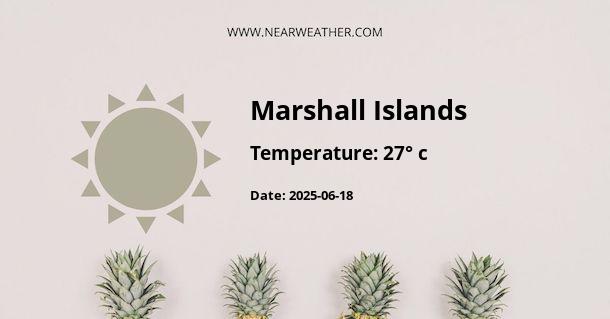Climate and Weather in the Republic of the Marshall Islands
The Republic of the Marshall Islands is a Pacific island country located near the equator, consisting of 29 atolls and 5 isolated islands. The climate of the Marshall Islands is characterized by its tropical nature with warm temperatures and high humidity throughout the year. The country experiences a typical tropical rainforest climate, influenced by the trade winds and the surrounding ocean currents.
Temperature
The Marshall Islands have a consistently warm and tropical climate, with little variation in temperature throughout the year. The average daily temperature ranges from 80°F (27°C) to 90°F (32°C). The hottest months are from April to June, when temperatures can reach up to 95°F (35°C). The coolest months are from December to February, with temperatures dropping to around 75°F (24°C) at night.
The warm temperatures make the Marshall Islands an ideal destination for beach lovers and water enthusiasts. The water temperature remains warm throughout the year, ranging from 79°F (26°C) to 84°F (29°C), providing excellent conditions for swimming, snorkeling, and diving.
Rainfall
The Marshall Islands experience a significant amount of rainfall throughout the year, with the wettest months being from July to October. The country receives an average annual rainfall of around 100 inches (2,500 mm). The rain is often heavy but tends to be short-lived, with showers typically lasting for a few hours.
These rainfall patterns contribute to the lush vegetation and abundant flora found in the Marshall Islands. The rainforests and wetlands of the islands are home to a diverse range of plant and animal species.
Tropical Cyclones
The Marshall Islands are situated within the typhoon belt of the Pacific Ocean, making them vulnerable to tropical cyclones. The cyclone season in the Marshall Islands typically runs from June to November, with the peak activity occurring between August and October. During this period, the islands may experience strong winds, heavy rain, and storm surges.
It is important for visitors and residents to stay informed about weather updates and follow the guidance of local authorities during cyclone events. The Marshall Islands have a well-established disaster management system in place to monitor and respond to cyclones.
Sea Level Rise
One of the major concerns for the Marshall Islands is the impact of climate change, specifically sea level rise. The country's low-lying atolls are particularly vulnerable to rising sea levels, which can lead to coastal erosion, saltwater intrusion, and the risk of losing landmasses.
The government of the Marshall Islands, along with international partners, is actively working on adaptation and mitigation strategies to address the challenges posed by sea level rise. These efforts include coastal protection measures, sustainable land management practices, and promoting renewable energy sources to reduce carbon emissions.
Conclusion
The Republic of the Marshall Islands has a tropical climate with warm temperatures and high humidity year-round. The temperature remains consistently warm, with little variation throughout the year. The islands experience a significant amount of rainfall, especially during the wetter months from July to October. The country is also prone to tropical cyclones, with the cyclone season running from June to November. Additionally, the Marshall Islands face the threat of sea level rise due to climate change, requiring active efforts to adapt and mitigate the impacts.
A - Marshall Islands's Latitude is 7.113000 & Longitude is 171.235992.
A - Weather in Marshall Islands is 29° today.
A - Climate Conditions in Marshall Islands shows scattered clouds today.
A - Humidity in Marshall Islands is 74% today.
A - Wind speed in Marshall Islands is 29.63 km/h, flowing at 70° wind direction. today.
